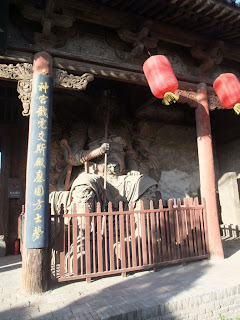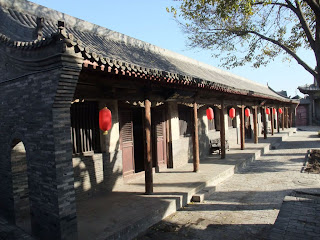
Pingyao City God Temple, located southeast of Pingyao ancient city along Chenghuang-miao Street is a solemn temple with distinct religious architectural history and culture. It is very famous for its grandeur scale and ingenious architectural construction. Over its total land area of 7302 sq. meter, the well preserved Taoist Temple comprises of three main building structures dedicated to The City God, God of wealth and Kitchen God. The culture of Taoism, Confucianism and folk culture are reflecting in its architectures, clay sculptures, mural paintings, wood carvings and tile carvings.. Pingyao City God Temple, one of the few intact Temples for City God in China, is a bright pearl in the various ancient architectures in Pingyao ancient city and a focus point at its landscape.



Pingyao City God Temple commonly known as Chenghuang-miao, was rebuilt in year 1544 after its founding during Ming Dynasty (1368-1644) and repaired in early Qing Dynasty (1644-1911). In year 1859, it was burnt down in a temple fair but reconstructed later in year 1864. The present buildings are in the typical architecture of Qing Style.


Chenghuang-miao is renowned for its long history and unique for its art form. The layout and internal structures show features of both Taoism and Confucianism. It is a right place to study the ceremonial system of the Pingyao City including its religious, architecture and cultural system.



The temple was deeply rooted in religious culture and well reflect in folks customs. The Chinese 12 horoscope stone carved water basins were interesting.


The Hall of City God Temple is the court of law for the gods. In the shrine hall, the Image of City God seated upright with judges and ghost guards standing by the side. The Hall had an atmosphere of some kind of eeriness rather than mystery or gloomy. The room downstairs is the site where City God handled special legal cases and also a place to receive his guests.



The roofs of the hall are beautifully adorned with colored glaze with predominant colors of blue and green. The shinny decorated blue and green glaze are gorgeous.


An exquisite and consummate structure.


Within the main temple there are hall for city god, theater hall and a living hall where the city god lived with his family dependents.



Its wood carvings together with its stone sculptures, painted sculptures and mural paintings reflect an excellent craftsmanship of ancient artisans.


Enjoy an interesting shadow play derived from a Chinese folk legend.



The Temple for the God of wealth (财神庙) enshrined with 3 delicately carved main images for people to make offerings and worship. The 3 sculptures look auspicious and delight. Painting on the walls depicts the great occasion of minorities coming a long way to present tribute to Emperor (朝贡图). The site also included a Zhenwu Pavilion (真武宫)for Taoist Supreme God and a Theater Hall for shadow play.


The building features magnificent architectural construction and color glaze art.



There was a Jigong-ci ancestral hall at The Temple of City God built by the folks, in memory to the contribution of an erudite scholar named Ci-Xianpin who lived in Pingyao City in Qing Dynasty during the reign of Emperor Qianlong. He managed the repair work for the temple for 10 years in 1771 and finally died due to over strenuous in hard-work, soon after the completion of the project.



Kitchen God is one of the most reliable and reputable god in most Chinese's belief. The mythological legend said that the Kitchen God was sent down to human realm to supervise people's conduct and make reports to Jade Emperor God of Heaven who in return based on the reports and made rewards or punishments to people. The Kitchen God returned to heaven on end of every lunar year and people to order to avoid bad deeds being reported and received punishments, would bribe him by offering him with tasty sweet deserts.




Wax figures were most realistic.


The dragon relief at the great Pingyao operation house next to Wenmiao (文庙).


Wen-miao (文庙), A Confucius Temple which is also a national cultural relic protected unit, was just opened to public in year 2004. It was first built in early reign of Emperor Taizhong (627-649) in Tang Dynasty (618-907) as a Temple of Confucius and rebuilt in 1163 in Jin Dynasty (1115-1234) during the reign of Emperor Shizong. It was then given a name as Confucius Temple and the Hall as Dacheng Palace (大成殿).



The Pingyao Confucius Temple is China's oldest preserved Confucius Temple. The temple had been damaged and destroyed over the years. The present vast memorial temple complex was restored and expanded in mid 12th century to its present format, and the pillars of temple were the reconstruction material from year 1163. This was the only example of Jin's Confucian temple architecture to be found in China. There are 87 sculptures of Confucius and his disciples at the site, which is considered the largest group in any Confucius temple in China.



The outstanding stone carved wall screen.




There is an outstanding stone carved marine turtle with two red character in front of the main hall gate. It was believed that the creature lived in South China Sea during Nuwa's era when she formed the world and created mankind. During Tang and Song Dynasty (618-1368), stone dragon and marine turtle relief were placed at the front part of the stairway where those who had passed the Imperial Examination lined up to receive the awards and person with highest score happened to stand just right in front of the turtle relief. People began to address those who was first in line in study as "独占鳌头 Solely Occupy the Turtle Head ". Xu-Jiyu (徐继畬), a native from Wutai County of Shanxi, had been awarded the highest degree in Imperial Examination in year 1826 and appointed in a position in the prestigious Hanlin Academy. He was a high ranking Imperial official and geographer in late Qing Dynasty. The statue was erected in memory to his achievement in study and career.




Offering sacrifices to heaven was an important religious ceremony in ancient China. Both Emperor and normal commoners were devoted to worship nature and pray for it as it was believed that by doing so, one could get great blessings.



The huge rectangular brass cauldron which were used to make sacrifice offerings.


Dragon Gate which means one succeeds in victory in their education or career. The story said that thousands of carps while swimming against water, was blocked by flood gate of the dam. They kept on jumping high to try in crossing over but hurt and failed. Until one day there was a carp jumped high enough and successfully across over to the other side of the water and changed into a dragon. The legend represents a person who worked very hard and over came the barrier to gain great success in his education or career.


The magnificent Library Pavilion.



The colors and symbolized animals or birds embossed on the costume wore by imperial officials were representation of the rank of the officers from grade 7 to grade 1.


The early abacus, example of Chinese early calligraphy and correspondent letters hand written by China famous calligrapher Wang-Xizhi (王羲之字帖), many of which are now the precious collection relics in museums and by persons.



The one and the only one Ming Dynasty examination scroll with highest score (状元卷)remained from the 1300 years of Confucius Imperial Examination. The 6 red letters on the scroll was attested by the Emperor's hand-writing. The priceless Ming awarded No. 1 examination scroll containing 2460 characters, was 3.3 meter long with width 38cm. It was the paper of Zhou-Bingzhong (赵秉忠) in year 1598.



The history of the ancient Imperial examination system (科举) began from Sui Dynasty and ended up in late Qing Dynasty, had been practicing for 1300 years in 6 dynasties (Sui, Tang, Song, Yuan, Ming and Qing from year 581 to 1911).


These are ancient reading books.

Volume of Confucius teachings had been passed down generations by generations and became the compulsory text for education in ancient China.



Various models of ancient wooden cargo carts and carriages.



Qingsi-Guan (清虚观) that sits at the north side of the East Avenue is another historical Temple of Taoism. It was first built in Tang Dynasty and prospered in Yuan Dynasty. The site was used to be a venue where eminent people and scholars frequently visited to study and meditate on Tao's Teachings.

A black stone tablet engraved with image of Taoist respectful Deity Li-Dongbing (吕洞宾) and his powerful mantra (咒符), stand right in front of the building. Deity Li-Dongbing was one of the Chinese popular eight deities (八仙) in the legend. He was borne in year 796 in Yongle at Rui-cheng town in Yuncheng (运城市芮城永乐镇) with Li-Yan (吕岩) as his birth name. He originally was a scholar but later followed the teachings of Taoism and finally attained achievement as a deity. He was highly respected by folks as he liked to use his power to make necessary contributions to the society and help people who were in trouble or problem. It was believed that whoever put the palm over his mantra, their dreams on education and career would come true.



The temple site which covers about 6,000 sq. meter, composed of 3 exhibitions include Taoist civilization, its history and its cultural relics. One of the perfectly preserved relics at the site, are those statues of opera actors, vivid in shape and sharp in color.


The site also has various statues of Buddhist images dating back to Ming and Qing Dynasty, like the huge statues of the four heavenly Kings in Hall of Taiping-Xingguo-Guan (太平兴国观).



Chunyang-Gong (纯阳宫) and Sanqing-Dian (三清殿) are the two main shrine halls of Taoist Temple. One enshrined with Taoist Master Deity Li-Dongbing (吕洞宾祖师) and the other enshrined with Taoist three main supreme god.



The interesting Qingsi-Guan is a place of interest for those who like local featured architecture and artwork especially its wood carvings.



No comments:
Post a Comment